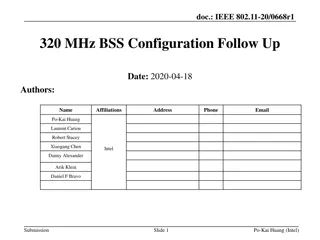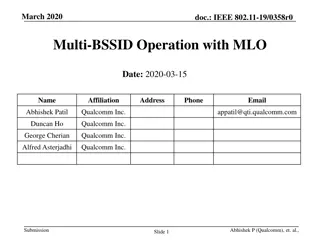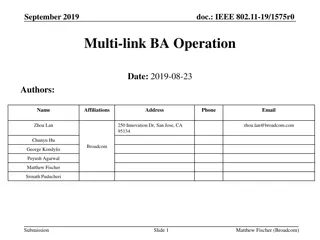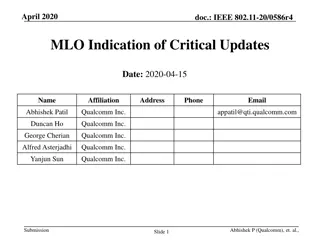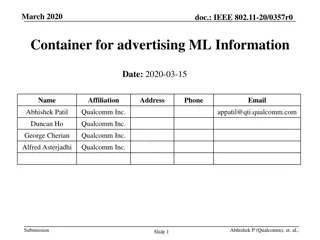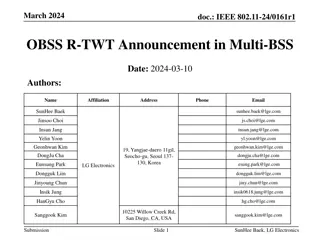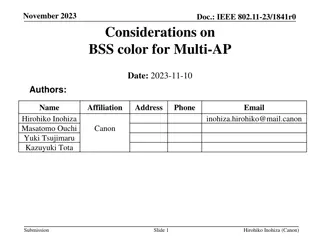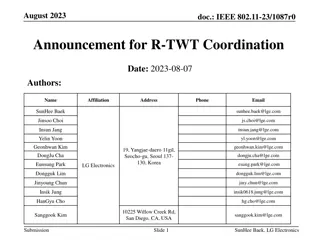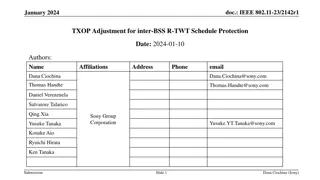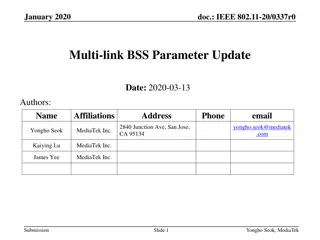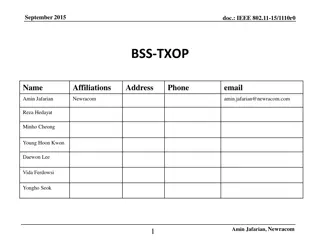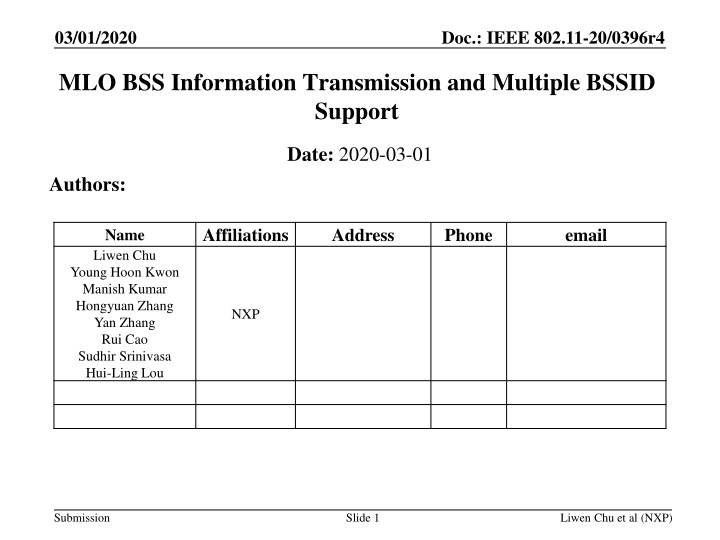
IEEE 802.11-20/0396r4 BSS Information Transmission
Explore the concepts of multiple BSSID support in IEEE 802.11-20/0396r4, detailing how APs transmit management frames, define non-transmitted BSSID profiles, and configure multiple BSSID APs. Learn about AP MLDs, security policies, medium access procedures, and more in this in-depth analysis.
Download Presentation

Please find below an Image/Link to download the presentation.
The content on the website is provided AS IS for your information and personal use only. It may not be sold, licensed, or shared on other websites without obtaining consent from the author. If you encounter any issues during the download, it is possible that the publisher has removed the file from their server.
You are allowed to download the files provided on this website for personal or commercial use, subject to the condition that they are used lawfully. All files are the property of their respective owners.
The content on the website is provided AS IS for your information and personal use only. It may not be sold, licensed, or shared on other websites without obtaining consent from the author.
E N D
Presentation Transcript
03/01/2020 Doc.: IEEE 802.11-20/0396r4 MLO BSS Information Transmission and Multiple BSSID Support Date: 2020-03-01 Authors: Affiliations Address Phone email Name Liwen Chu Young Hoon Kwon Manish Kumar Hongyuan Zhang Yan Zhang Rui Cao Sudhir Srinivasa Hui-Ling Lou NXP Submission Slide 1 Liwen Chu et al (NXP)
03/01/2020 Doc.: IEEE 802.11-20/0396r4 Recap: Multiple BSSID A single-radio AP device can own multiple virtual APs: Only one AP that has transmitted BSSID transmits management frame frames. The BSSIDs of the other APs are non- transmitted BSSID. The Multiple BSSID element defines the non-transmitted BSSID profiles for APs that have non-transmitted BSSIDs. The non-transmitted BSSID can be figured out through the Multiple BSSID element. Multiple BSSID Configuration element defines the actually number of non transmitted BSSID APs. The non-transmitted profile of a non-transmitted BSSID in the management frame doesn t need to carry an element of the AP s capabilities or operating parameters that is same as the related element of the transmitted BSSID. One example is that if the EDCA Parameter Set element is not in the non-transmitted BSSID profile of an AP with non-transmitted BSSID ( e.g. AP2), the EDCA Parameter Set element in the management frame will be used by the STAs associated with AP2. An AP with non-transmitted BSSID may announce the non-inheritance of element from the AP with transmitted BSSID. One example is that in non-Transmitted BSSID Profile of non-transmitted BSSID1, if the Element ID of EDCA Parameter Set is in List Of Element IDs field, the EDCA Parameter Set element in the management frame will not be used by the STAs associated with AP of BSSID1. Non-inherit element Multiple BSSID element Multiple BSSID AP Transmitted BSSID BSSID1, BSSID2 BSSID3, BSSID4 Liwen Chu et al (NXP) Multiple BSSID Configuration element Submission Slide 2
03/01/2020 Doc.: IEEE 802.11-20/0396r4 Recap: AP MLD An AP multi-link device (MLD) includes multiple APs: Each AP works in different link. All the APs share the same security policy, BA agreement, SSID, same MAC SAP. The APs have different medium access procedures. Each AP may transmit its own management frames with different TSF time, BI, TBTT etc. When an AP of an AP MLD transmits a management frame in link1, the management frame doesn t need to carry a element of another AP s capabilities or operating parameters in link2 if the element is same as the related element in link1. In a management frame of link1, the information of an AP in link2 may not include an element of the specific capabilities or operating parameters, and the AP in link2 doesn t want to inherit the related element in link1 The non-inherit Information (identified by the Element ID, Element ID Extension) can be announced to let the STAs associated with the AP in link2 know the element that are not inherited from the AP that transmitted the management frame in link1. The AP MLD transmits buffered frame indication of one link in another link. The buffer indication of the other link takes effect right away or after the following TBTT of another link. No indication about whether this applied to unicast or group-addressed frames. This may not be applicable to group addressed frames. SAP of BSSID1 (addr1) Multi-link AP device BSSID1 s management frame Common MAC capabilities, operation parameters of AP with BSSID1 MAC with Addr1 MAC with Addr2 RNR ML element with Link ID, SAP Addr, capability, operation parameters of AP with BSSID2 Link 2 Link 1 Submission Slide 3 Liwen Chu et al (NXP)
03/01/2020 Doc.: IEEE 802.11-20/0396r4 Number of AP MLD with Multiple BSSID in Multiple Links It is not required that when one link implements multiple BSSID, another link also needs to implement multiple BSSID. 5GHz legacy STAs, 6GHz HE STAs, and 5GHz + 6GHz STA MLDs When two links implement multiple BSSID, the following are the relationship of them: Option 1: If an AP in a link that is affiliated with an AP MLD has transmitted BSSID, the AP in another link that is affiliated with the same AP MLD is the transmitted BSSID. Option 1.1: The Multiple BSSID elements in different links define the same number of non-transmitted BSSIDs. Option 1.2: The Multiple BSSID elements in different links define the different number of non-transmitted BSSIDs. Option 2: If an AP in a link that is affiliated with an AP MLD has transmitted BSSID, the AP in another link that is affiliated with the same AP MLD can be a non-transmitted BSSID. Option 2.1: The Multiple BSSID elements in different links define the same number of non-transmitted BSSIDs. Option 2.2: The Multiple BSSID elements in different links define the different number of non-transmitted BSSIDs. We prefer option 2.2. SAP of BSSID13 (addr13) SAP of BSSID12 (addr12) SAP of BSSID14 (addr14) SAP of BSSID11 (addr11) AP MLD3 AP MLD2 AP MLD4 AP MLD1 Common MAC Common MAC Common MAC Common MAC MAC with Addr14 (AP14) MAC with Addr24 (AP24) MAC with Addr13 (AP13) MAC with Addr23 (AP23) MAC with Addr11 (AP11) MAC with Addr21 (AP21) MAC with Addr12 (AP12) MAC with Addr22 (AP22) Link2 Link2 Link2 Link2 Link1 Link1 Link1 Link1 Submission Slide 4 Liwen Chu et al (NXP)
03/01/2020 Doc.: IEEE 802.11-20/0396r4 BSS Parameter Transmission Method of AP MLD with Multiple BSSID This method assume that the transmitted BSSIDs of multiple links can be affiliated with different AP MLDs. The method to transmit BSS parameters: APxa s capabilities and operating parameters APxa s non-transmitted BSSID profiles of the non-transmitted BSSIDs in link_x each non-transmitted BSSID profile of link_x s APxb includes the capabilities, operating parameters of link_y s APyb where APxb and APyb are owned by same AP MLD the AP capabilities and BSS operating parameters of transmitted BSSID AP (APyb) in link_y. RNR is used for non-EHT STAs and most basic AP MLD announcement. The link identifier (MLD ID + Link ID) in RNR and ML element defines the match between RNR and STA Profile in ML element. Non-transmit BSSID Profiles subelement for AP12, AP13, AP14. ML elements related to AP12, AP13, AP14 Elements for AP11 s capabilities, operating parameters RNR AP11 s Beacon ML element with Link ID, SAP Addr, capability, operation parameters of AP 21 SAP of BSSID13 (addr13) SAP of BSSID12 (addr12) SAP of BSSID14 (addr14) SAP of BSSID11 (addr11) AP MLD3 AP MLD2 AP MLD4 AP MLD1 Common MAC Common MAC Common MAC Common MAC MAC with Addr14 (AP14) MAC with Addr24 (AP24) MAC with Addr13 (AP13) MAC with Addr23 (AP23) MAC with Addr11 (AP11) MAC with Addr21 (AP21) MAC with Addr12 (AP12) MAC with Addr22 (AP22) Link2 Link2 Link2 Link2 Link1 Link1 Link1 Link1 APs with Addr11, 12, 13, 14 are defined by a Multiple BSSID element. APs with Addr21, 22, 23, 24 are defined by a Multiple BSSID element. Submission Slide 5 Liwen Chu et al (NXP)
03/01/2020 Doc.: IEEE 802.11-20/0396r4 BSS Parameter Transmission Method of AP MLD with Multiple BSSID The method to inherit the parameters: APs affiliated with the same AP MLD as the non-transmitted BSSID AP inherit from the non-transmitted BSSID AP and then inherit from the AP that transmits the Beacon. APs affiliated with the same AP MLD as the transmit AP inherit from the AP that transmits the Beacon. Non-transmit BSSID Profiles subelement for AP12, AP13, AP14. ML elements related to AP12, AP13, AP14 Elements for AP11 s capabilities, operating parameters RNR AP11 s Beacon ML element with SAP Addr, STR/NSTR capability per pair of links, STA Profile (Link ID, capability, operation parameters) of AP 21 SAP of BSSID13 (addr13) SAP of BSSID12 (addr12) SAP of BSSID14 (addr14) SAP of BSSID11 (addr11) AP MLD3 AP MLD2 AP MLD4 AP MLD1 Common MAC Common MAC Common MAC Common MAC MAC with Addr14 (AP14) MAC with Addr24 (AP24) MAC with Addr13 (AP13) MAC with Addr23 (AP23) MAC with Addr11 (AP11) MAC with Addr21 (AP21) MAC with Addr12 (AP12) MAC with Addr22 (AP22) Link2 Link2 Link2 Link2 Link1 Link1 Link1 Link1 Submission Slide 6 Liwen Chu et al (NXP)
03/01/2020 Doc.: IEEE 802.11-20/0396r4 BSS Parameter Transmission Method of AP MLD with Multiple BSSID (Cont d) The AP MLD reported by RNR may not include AP in the reporting link, e.g. AP MLD with addr34 SAP address. The reporting method of such AP MLD: AP s report with the announcement of belonging to AP MLD through RNR only. AP MLD report without MLD common info and STA profile. The MLD ID + Link ID can be BSSID Index + Link ID. AP s report with ML element. More than one ML elements exist in the Management frame. The MLD ID + Link ID can t be BSSID Index + Link ID. The rule could be If an MP MLD has an AP in the link where the management frame is transmitted, the ML element with Common Info and STA profile for the AP MLD is included in the Management frame. Otherwise the RNR is used to announce the AP MLD. Elements for AP11 s capabilities, operating parameters Non-transmit BSSID Profiles subelement for AP12, AP13, AP. ML IEs related to AP12, AP13, RNR for AP21 to AP24 Elements for AP11 s capabilities, operating parameters Non-transmit BSSID Profiles subelement for AP12, AP13, AP. ML IEs related to AP12, AP13, RNR for AP21 to AP24 ML element with Link ID, SAP Addr, capability, operation parameters of AP 21 AP11 s Beacon option 2 ML element with Link ID, SAP Addr, capability, operation parameters of AP 21 ML element of AP24 AP11 s Beacon option 1 SAP of BSSID13 (addr13) SAP of BSSID12 (addr12) SAP of BSSID11 (addr11) SAP of BSSID34 (addr34) MAC with Addr14 (A34) AP MLD3 AP MLD2 AP MLD1 AP MLD4 Common MAC Common MAC Common MAC Common MAC Link3 MAC with Addr13 (AP13) MAC with Addr23 (AP23) MAC with Addr11 (AP11) MAC with Addr21 (AP21) MAC with Addr12 (AP12) MAC with Addr22 (AP22) MAC with Addr24 (AP24) Link2 Link2 Link2 Link1 Link1 Link1 Link2 Submission Slide 7 Liwen Chu et al (NXP)
03/01/2020 Doc.: IEEE 802.11-20/0396r4 Straw Poll 1 Do you support that it is not required that when one link implements multiple BSSID, another link also needs to implement multiple BSSID? Submission Slide 8 Liwen Chu et al (NXP)
03/01/2020 Doc.: IEEE 802.11-20/0396r4 Straw Poll 2 Do you support that if an AP in a link that is affiliated with an AP MLD has transmitted BSSID, the AP in another link that is affiliated with the same AP MLD is not required to be the transmitted BSSID? Submission Slide 9 Liwen Chu et al (NXP)
03/01/2020 Doc.: IEEE 802.11-20/0396r4 SP 3 Do you support that when an AP MLD reported by RNR doesn t not include AP in the reporting link where the Beacon or Probe Response is transmitted, the ML element of the AP MLD is not required to carried in the beacon or Probe Response frame? Submission Slide 10 Liwen Chu et al (NXP)
03/01/2020 Doc.: IEEE 802.11-20/0396r4 SP 4 Do you support that the MLDID + Link ID in RNR is used to match the RNR and the ML element of the reported MLD? Submission Slide 11 Liwen Chu et al (NXP)


